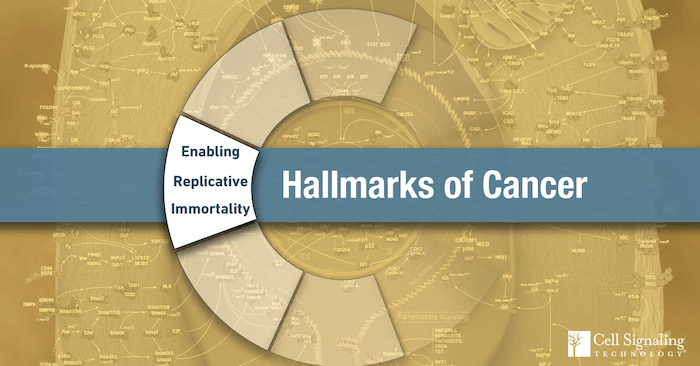Cancer cells can revert to a pre-differentiated, stem-cell-like phenotype, allowing uninhibited cellular division and other metabolic adaptations that enable survival in adverse conditions.
While there are multiple signaling pathways involved in these changes, two key components enable replicative immortality, Hippo and WNT. There are multiple pathways involved in this characteristic of cancer cells. Below, we'll focus on two of these key pathways: Hippo signaling and Wnt signaling.
The Hallmarks of Cancer are seminal manuscripts by Doctors Robert Weinberg and Douglas Hanahan and were published in Cell1. The authors proposed the idea that the complexity of cancer can be broken down into smaller subsets of underlying principles. The information here pertains to one Hallmark of Cancer, known as "Enabling Replicative Immortality." Other entries in this series explore the other proposed Hallmarks.
Hippo Signaling
Hippo signaling is an evolutionarily conserved pathway that controls organ size by regulating cell proliferation, apoptosis, and stem cell self-renewal. In addition, dysregulation of the Hippo pathway contributes to cancer development. Important targets include:
- YAP and TAZ are key mediators to Hippo signaling. YAP acts as a transcriptional co-activator, can be phosphorylated at multiple sites, and translocates from the nucleus to the cytoplasm
- When the Hippo pathway is turned off, YAP is phosphorylated, translocates to the nucleus, and is associated with various transcription factors, including the TEAD and YAP/TEAD complexes, which regulate the expression of genes involved in cell proliferation and apoptosis.
Wnt/β-Catenin Pathway
The Wnt/β-Catenin pathway is another evolutionarily conserved mechanism that contributed to cancer's ability to replicate indefinitely. This pathway regulates stem cell pluripotency and cell fate decisions during development. Wnt signaling has also been shown to promote nuclear accumulation of transcriptional regulators implicated in cancer, such as TAZ. Key regulators include:
- β-Catenin is a key downstream effector in the Wnt signaling pathway. It is implicated in two major biological processes in vertebrates: early embryonic development and tumorigenesis. It can translocate to the nucleus.
- LEF1 and TCF bind to Wnt response elements to provide docking sites for β-catenin, which translocates to the nucleus to promote the transcription of target genes upon activation of Wnt signaling.
Additional Resources
Read the additional blog posts in the Hallmarks of Cancer series to learn more:
- Resisting Cell Death
- Deregulating Cellular Energetics
- Inducing Angiogenesis Energetics
- Sustaining Proliferative Signaling
- Evading Growth Suppressors
- Activation Invasion and Metastasis
- Tumor Promoting Inflammation
- Genome Instability and Mutation
- Avoiding Immune Destruction
Select References
- Hanahan D, Weinberg RA (January 2000). "The Hallmarks of Cancer". Cell. 100 (1): 57–70. doi:10.1016/S0092-8674(00)81683-9
- Hanahan D, Weinberg RA (March 2011). "Hallmarks of Cancer: the next generation". Cell. 144 (5):646-74. doi: 10.1016/j.cell.2011.02.013.
18-CEL-47955







/42157_chimeric%20antibody%20blog%20featured3.webp)


